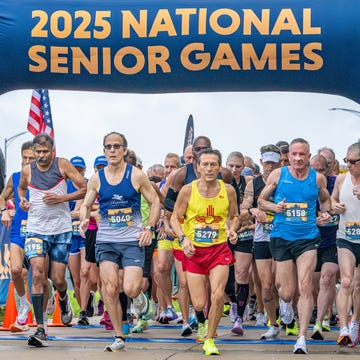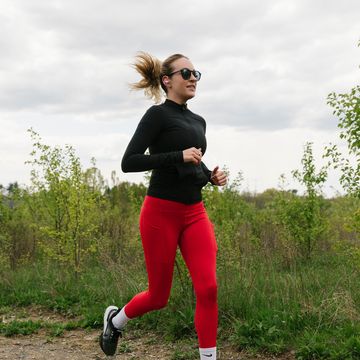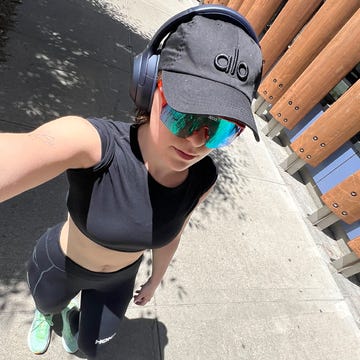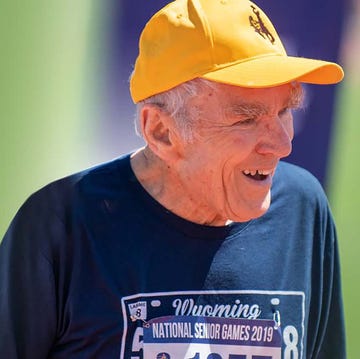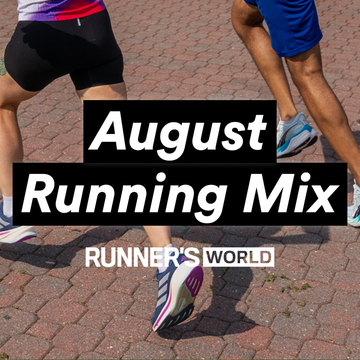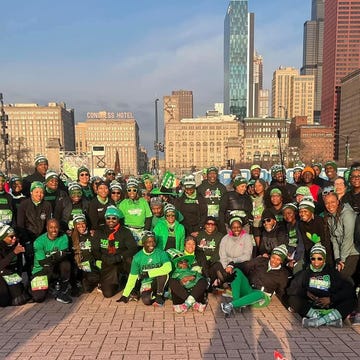Editor’s Note: Keira D’Amato retired from running at 24 (at least that’s what she thought), only to find her way back to the sport in her early 30s. First, it was just for fun, but then she ran 2:44:03 at the 2018 Grandma’s Marathon in Duluth, Minnesota. At that point, with the support of her husband, Anthony D’Amato, and her then-coach, Scott Raczko, she had a decision to make: Should she rejoin elite running and risk burning out like she had during what she refers to as Round One of her career, or play it safe and keep running on vibes? She recounts this existential dilemma in the following excerpt from her new memoir, Don’t Call It a Comeback: What Happened When I Stopped Chasing PRs, and Started Chasing Happiness.
Back when I was in college, my dad told me that he could always predict when I was going to have a good race: He could see me smiling, laughing, goofing off, talking shit, relaxed. If he noticed I was grim and withdrawn, he started to worry. And on those days, I never did my best.
I sometimes wish it didn’t take me an injury, an eight- year hiatus, a marriage, two children, therapy, and liters of tears to figure this out. And when I finally did, I was fearful that I’d lose what I learned all over again. It’s the main reason I was having such a hard time deciding whether to start training more seriously after Grandma’s Marathon. I’d been measuring my progress in terms of how much fun I had, not whether I hit a self-imposed and arbitrary goal. It was a safe space: I could temper my expectations and frame them around my experience, not my results. I even started calling it my “fun shield”—I could protect myself from failing because I could always hide behind this is fun. If I didn’t run as fast as I’d hoped to run, well, it didn’t matter as long as I had a heck of a good time. It was my way of sandbagging; I kept my bets just low enough that I could surpass and surprise myself—and everyone else—most of the time. And when I didn’t, I could maintain that I didn’t have any goals at all. I was self-deprecating in advance.
If I stepped out from behind the fun shield and admitted to myself (and the running community, and beyond) that I was trying to level up, it was increasing the heights from which I could fall and the disappointment I might feel. It seemed like fun and failure couldn’t coexist.
When I was in my twenties, I had all the time in the world to conjure up fun, and running was the work. Now, with a family and a mortgage and a job, the run was the fun. If I went for it, would I have to go back to Round One?
I sat myself down and put together a list of what was important to me and what, in practice, fun in running actually meant for me:
Fun is flexibility. When I feel like running longer, I want to run longer. I didn’t want to be completely rigid. Raczko understood, but we both knew flexibility can only go so far. Intentionality is not flying by the seat of your Underoos. He started giving me weekly mileage and workouts for me to fit in when my schedule allowed, under one condition: I had to fit them in. If I said, “I’m too busy,” that wouldn’t do.
Fun is racing. I know some elite marathoners who only race once or twice a year at any distance. But I love to race. We agreed that I could race if the events made sense—if they substituted for a key workout or fit well into a build.
Fun is not racing on the track. I tried it a few times in Round Two, and I finally admitted to myself that I hated it. Track is intense. Repetitive. Everyone is close together. You can’t escape the splits that flash on giant clocks everywhere. It’s tight, aggressive, claustrophobic. You feel like every step, every possible stumble, is under scrutiny. Not only that, every track oval is just . . . an oval. Road racing is so much more my cup of tea: open space. Great views. Different neighborhoods. Distractions—even if it’s just figuring out how to handle a water stop or find the quickest tangent. Even if you’re in a pack on the road, you can get into your own rhythm and focus on yourself. It’s harder to compare yourself to other people in other places. And the energy that comes from sometimes lining up with fifty thousand people? It’s incredible.
Fun is family. I knew that I needed to figure out how to integrate Anthony and the kids into my future as a runner, whether that meant they traveled to races with me, watched me do track workouts, or even kept me from doing every training session at the planned time and place. (See flexibility. You can’t predict when one kid’s diaper will leak or the other kid will wake up eight times in a single night.)
Fun is community, openness, inclusivity. After trying so hard to make running friends in Richmond, I didn’t want to turn inward. By the time I got my OTQ, I’d been on Strava for almost two years, and the novelty still hadn’t worn off. In fact, my account was taking on a life of its own: I started titling every single run with a pun or a joke. I’d randomly done it a few times before, but it made me chuckle, so I began to do it every day. These weren’t sophisticated: one of my sources was the Popsicles that had jokes on the sticks. My kids (and I) loved it because, marketing genius alert, you had to eat more Popsicles to get more jokes.
When I discussed my dilemma with Anthony, he was supportive— he is a huge advocate for striving to be the best version of yourself, whether it’s by establishing family goals, personal goals, or professional goals. (He used to say that he didn’t want life insurance because he didn’t want to bet against himself.) I think Anthony understood why I needed to find my limits, even though he still thought running would remain a hobby. We both knew it would be more stressful for him—picking up the slack when I traveled, wrangling kids (or childcare) while I went for long runs, letting running be as close to my job as possible. It wasn’t lost on me that it’s what a lot of women juggle all the time, and what I struggled to handle while he was deployed. To be honest, the division of labor in our relationship is never going to be easy or perfectly calibrated.
Not long after Grandma’s, I found myself at a trendy restaurant in Arlington seated next to an author and coach named Matt Fitzgerald. (By now, he’s written close to thirty books about running and training— titles like 80/20 Running, Running the Dream, and Run Like a Pro.) A friend from Potomac River Running was putting on an author event for Matt at the uber-cool Ballston Quarter mall auditorium, and I’d come up to show him some houses. The restaurant was the kind with lots of rare, cascading plants on the walls. Shared plates. Hipper-than-hip servers. I ordered brussels sprouts, which is unimportant, except I remember it so vividly.
I didn’t know Matt, but I started unloading on him. “I’m having so much fun,” I said. “Should I go all-in? I know I can do something great. Will it stop being fun?” I was trying to lay out my existential dilemma to him. It reminded me of when I talked to my uncle about my injury. I’m not usually one to ask for advice—but in a pinch, I ask everyone.
Matt smiled and nodded; he probably thought I was a cuckoo clock. “Sure, go for it,” he said, not dismissively, but aggressively noncommittal.
My friend chimed in, “You don’t understand. Keira’s got it. You have no idea.”
Matt said, and I’m paraphrasing big- time, “Yeah, either go for it, or not, it’s fine, do whatever you want.” And a few minutes later he said, “Why would you not go for it?”
It was a good question. What people didn’t grasp was how desperately I needed running to be joyful for me, to be positive, no matter the outcome. I was terrified that if I decided to train more seriously, I had to approach the sport like I did in Round One. But now I had such a different jumping- off point than I did before: I’d already lost running once and figured out, slowly, gradually, how to get it back. If I lost my way again, I could get it back—again. I was running faster than I ever had in my life, and I was relishing it. Why the F wouldn’t I, at the very least, give it a try?
Running rescued me from a mental and physical rut. I realized that I wasn’t afraid to fail as a runner, but I was afraid to go back down into that rut. I could live with not being faster, but I couldn’t live with regret. I didn’t want to be left wondering what could have been. Regret is worse than failure. (And even worse than that? Not trying.)
I wasn’t ready to coast. I’d qualified for the Trials. Even though I was ranked around 100th in the field, maybe even 150th, I was going to train to make the Olympic team. Matt and I laugh about it now. But after that (stilted, awkward) conversation, I’d made my decision.
I started training at a level that I couldn’t quite believe. In one tempo, a series of three-mile repeats, I extended one to a full 5K—and almost set a PR. I was seeing signs that I was becoming the best runner I’d ever been, but it wasn’t yet translating to racing. Maybe my mentality was still stuck in a timid Round One mindset. Maybe my fitness was improving more than I could ever have hoped.
And, man, it was fun. Not slapstick, not corny, but an emotional experience closer to pride and accomplishment and delighted surprise. Reaching new heights, at such a quick rate, was hella joyful. It fulfilled me in ways that slapstick never could—but I still left plenty of room for goofing off, too, and kept my recovery runs light. I wasn’t worried about being judged if I made a joke during practice because my times were speaking for themselves. My nervousness was the butterfly kind, not the stomachache kind. I was done comparing myself to anyone else. It’s as if I finally figured out how to truly manifest Killer Keira: it was a paradox that had fallen into place at last.
Raczko saw what was happening. But he didn’t tell me what he thought I was capable of. He just waited, patiently, for me to figure it out on my own.
From Don’t Call It a Comeback: What Happened When I Stopped Chasing PRs, and Started Chasing Happiness by Keira D’Amato with Evelyn Spence. Copyright © 2025 by the author and reprinted by permission of St. Martin’s Publishing Group.








